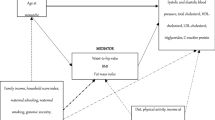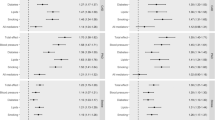Abstract
Having a later age at menopause is associated with having a higher blood pressure (BP) value, but the mediation pathways remain unclear. We quantitatively examined the mediation effects of various obesity indicators using baseline data from phase 4 of the Guangzhou Biobank Cohort Study. The product of coefficients approach and bootstrapping procedures were used to assess the mediation effects of body mass index (BMI), waist circumference (WC), waist-to-hip ratio (WHR) and waist-to-height ratio (WHtR) on the association between age at menopause and BP values. Age, education, occupation, family income, smoking, drinking, diet, physical activity, age at menarche, number of births, fasting glucose, triglycerides, and high-density lipoprotein cholesterol were adjusted as covariates. Of 5429 women with natural menopause, the mean age and menopausal age were 60.0 (standard deviation = 5.8) and 50.3 (3.1) years, respectively. The prevalence of hypertension was 29.6%. In women with a menopausal age of ≥50 years, BMI, WC, WHR and WHtR showed significant mediation effects on the positive association between menopausal age and BP. The adjusted proportion (95% confidence interval) of the mediation effects for those variables were 26.04% (10.40–116.82%), 25.92% (10.19–108.57%), 14.11% (3.59–62.78%), and 23.17% (8.70–95.81%), respectively, for systolic BP values and 22.59% (10.72–53.60%), 20.67% (9.83–49.31%), 9.21% (2.73–23.92%), and 17.19% (7.56–41.31%) for diastolic BP values. In women with a menopausal age of <50 years, no significant association between age at menopause and systolic/diastolic BP values was found. In conclusion, obesity indicators showed significant mediating effects on the association between having a later age at menopause and having a higher BP value. Further longitudinal studies with detailed and accurate measurements of metabolic changes after menopause and sufficient follow-up are warranted to confirm these results.

We demonstrated obesity indicators showed significant mediating effects on the association between later age at menopause (≥50 years) and higher BP.
This is a preview of subscription content, access via your institution
Access options
Subscribe to this journal
Receive 12 print issues and online access
$259.00 per year
only $21.58 per issue
Buy this article
- Purchase on Springer Link
- Instant access to full article PDF
Prices may be subject to local taxes which are calculated during checkout


Similar content being viewed by others
References
Poulter NR, Prabhakaran D, Caulfield M. Hypertension. Lancet. 2015;386:801–12.
Collaboration NCDRF. Worldwide trends in hypertension prevalence and progress in treatment and control from 1990 to 2019: a pooled analysis of 1201 population-representative studies with 104 million participants. Lancet. 2021;398:957–80.
Bao M, Wang L. The longitudinal trend of hypertension prevalence in Chinese adults from 1959 to 2018: a systematic review and meta-analysis. Ann Palliat Med. 2020;9:2485–97.
Mills KT, Stefanescu A, He J. The global epidemiology of hypertension. Nat Rev Nephrol. 2020;16:223–37.
Brahmbhatt Y, Gupta M, Hamrahian S. Hypertension in premenopausal and postmenopausal women. Curr Hypertens Rep. 2019;21:74.
Ang SB, How CH. Menopause: an important milestone in women’s health. Singap Med J. 2013;54:60–3.
Yang L, Li L, Millwood IY, Lewington S, Guo Y, Sherliker P, et al. Adiposity in relation to age at menarche and other reproductive factors among 300,000 Chinese women: findings from China Kadoorie Biobank study. Int J Epidemiol. 2017;46:502–12.
Yu Y, Li J, Jiang Y, Zaid M, Zhao Q, Wang N, et al. Association between reproductive factors and type 2 diabetes: a cross-sectional study. Int J Environ Res Public Health. 2022;19:1019.
Roa-Diaz ZM, Asllanaj E, Amin HA, Rojas LZ, Nano J, Ikram MA, et al. Age at natural menopause and blood pressure traits: mendelian randomization study. J Clin Med. 2021;10:4299.
Shen L, Wang L, Hu Y, Liu T, Guo J, Shen Y, et al. Associations of the ages at menarche and menopause with blood pressure and hypertension among middle-aged and older Chinese women: a cross-sectional analysis of the baseline data of the China Health and Retirement Longitudinal Study. Hypertens Res. 2019;42:730–8.
Park CY, Lim JY, Park HY. Age at natural menopause in Koreans: secular trends and influences thereon. Menopause. 2018;25:423–9.
Deng WW, Wang J, Liu MM, Wang D, Zhao Y, Liu YQ, et al. Body mass index compared with abdominal obesity indicators in relation to prehypertension and hypertension in adults: the CHPSNE study. Am J Hypertens. 2013;26:58–67.
Wang SK, Ma W, Wang S, Yi XR, Jia HY, Xue F. Obesity and its relationship with hypertension among adults 50 years and older in Jinan, China. PLoS One. 2014;9:e114424.
Jiang C, Thomas GN, Lam TH, Schooling CM, Zhang W, Lao X, et al. Cohort profile: The Guangzhou Biobank Cohort Study, a Guangzhou-Hong Kong-Birmingham collaboration. Int J Epidemiol. 2006;35:844–52.
Huang Y, Jiang C, Xu L, Zhang W, Zhu F, Jin Y, et al. Mortality in relation to changes in physical activity in middle-aged to older Chinese: an 8-year follow-up of the Guangzhou Biobank Cohort Study. J Sport Health Sci. 2021;10:430–8.
Deng HB, Macfarlane DJ, Thomas GN, Lao XQ, Jiang CQ, Cheng KK, et al. Reliability and validity of the IPAQ-Chinese: the Guangzhou Biobank Cohort study. Med Sci Sports Exerc. 2008;40:303–7.
Nelson HD. Menopause. Lancet. 2008;371:760–70.
Wang Y, Zhang WS, Hao YT, Jiang CQ, Jin YL, Cheng KK, et al. Changes in blood pressure and cardiovascular disease in middle-aged to older Chinese: the Guangzhou Biobank Cohort Study. J Hypertens. 2022;40:2005–12.
Zhang WS, Xu L, Schooling CM, Jiang CQ, Cheng KK, Liu B, et al. Effect of alcohol and aldehyde dehydrogenase gene polymorphisms on alcohol-associated hypertension: the Guangzhou Biobank Cohort Study. Hypertens Res. 2013;36:741–6.
1999 World Health Organization-International Society of Hypertension Guidelines for the Management of Hypertension. Guidelines Subcommittee. J Hypertens. 1999;17:151–83.
Valente MJ, Rijnhart JJM, Smyth HL, Muniz FB, MacKinnon DP. Causal Mediation Programs in R, Mplus, SAS, SPSS, and Stata. Struct Equ Modeling. 2020;27:975–84.
Lee JS, Hayashi K, Mishra G, Yasui T, Kubota T, Mizunuma H. Independent association between age at natural menopause and hypercholesterolemia, hypertension, and diabetes mellitus: Japan nurses’ health study. J Atheroscler Thromb. 2013;20:161–9.
Song L, Shen L, Li H, Liu B, Zheng X, Zhang L, et al. Age at natural menopause and hypertension among middle-aged and older Chinese women. J Hypertens. 2018;36:594–600.
Peters SA, Huxley RR, Woodward M. Women’s reproductive health factors and body adiposity: findings from the UK Biobank. Int J Obes (Lond). 2016;40:803–8.
Yang Q, Song C, Jiang J, Chen Y, Liang S, Ma N, et al. Association of reproductive history with hypertension and prehypertension in Chinese postmenopausal women: a population-based cross-sectional study. Hypertens Res. 2018;41:66–74.
Gupte AA, Pownall HJ, Hamilton DJ. Estrogen: an emerging regulator of insulin action and mitochondrial function. J Diabetes Res. 2015;2015:916585.
Mongraw-Chaffin ML, Anderson CA, Allison MA, Ouyang P, Szklo M, Vaidya D, et al. Association between sex hormones and adiposity: qualitative differences in women and men in the multi-ethnic study of atherosclerosis. J Clin Endocrinol Metab. 2015;100:E596–600.
Wang L, Szklo M, Folsom AR, Cook NR, Gapstur SM, Ouyang P. Endogenous sex hormones, blood pressure change, and risk of hypertension in postmenopausal women: the Multi-Ethnic Study of Atherosclerosis. Atherosclerosis. 2012;224:228–34.
Kalish GM, Barrett-Connor E, Laughlin GA, Gulanski BI. Postmenopausal Estrogen/Progestin Intervention T. Association of endogenous sex hormones and insulin resistance among postmenopausal women: results from the Postmenopausal Estrogen/Progestin Intervention Trial. J Clin Endocrinol Metab. 2003;88:1646–52.
Stork S, Bots ML, Grobbee DE, van der Schouw YT. Endogenous sex hormones and C-reactive protein in healthy postmenopausal women. J Intern Med. 2008;264:245–53.
Liu D, Qin P, Liu Y, Sun X, Li H, Wu X, et al. Association of age at menarche with hypertension in rural Chinese women. J Hypertens. 2021;39:476–83.
Zhang L, Li Y, Zhou W, Wang C, Dong X, Mao Z, et al. Mediation effect of BMI on the relationship between age at menarche and hypertension: The Henan Rural Cohort Study. J Hum Hypertens. 2020;34:448–56.
Katzer K, Hill JL, McIver KB, Foster MT. Lipedema and the potential role of estrogen in excessive adipose tissue accumulation. Int J Mol Sci. 2021;22:11720.
Sniderman AD, Bhopal R, Prabhakaran D, Sarrafzadegan N, Tchernof A. Why might South Asians be so susceptible to central obesity and its atherogenic consequences? The adipose tissue overflow hypothesis. Int J Epidemiol. 2007;36:220–5.
Acknowledgements
The Guangzhou Biobank Cohort Study investigators include the Guangzhou Twelfth People’s Hospital: WS Zhang, T Zhu, F Zhu, YL Jin, CQ Jiang (Co-PI); The University of Hong Kong: CM Schooling, SM McGhee, GM Leung, TH Lam (Co-PI); The University of Birmingham: GN Thomas, P Adab, KK Cheng (Co-PI).
Funding
This work was supported by the National Key R&D Program of China (2017YFC0907105) and the Natural Science Foundation of China (81941019). The Guangzhou Biobank Cohort Study was funded by the Guangzhou Twelfth People’s Hospital, The University of Hong Kong Foundation for Educational Development and Research (SN/1f/HKUF-DC; C20400.28505200), the Health Medical Research Fund (Grant number: HMRF/13143241) in Hong Kong; Guangzhou Public Health Bureau (201102A211004011) Natural Science Foundation of Guangdong (2018A030313140), and the University of Birmingham, UK.
Author information
Authors and Affiliations
Contributions
Y-JW, W-SZ, C-QJ, TZ, Y-LJ, FZ, B-JZ and LX made substantial contributions to the conception and design, acquisition of funding, data analysis and interpretation of data; Y-JW, W-SZ, C-QJ and LX analyzed the data and drafted the article, and W-SZ, C-QJ, LX and B-JZ revised it critically for important intellectual content. All authors have read and agreed to the published version of the manuscript.
Corresponding authors
Ethics declarations
Conflict of interest
The authors declare no competing interests.
Additional information
Publisher’s note Springer Nature remains neutral with regard to jurisdictional claims in published maps and institutional affiliations.
Supplementary Information
Rights and permissions
Springer Nature or its licensor (e.g. a society or other partner) holds exclusive rights to this article under a publishing agreement with the author(s) or other rightsholder(s); author self-archiving of the accepted manuscript version of this article is solely governed by the terms of such publishing agreement and applicable law.
About this article
Cite this article
Wu, YJ., Jiang, CQ., Zhu, T. et al. Obesity indicators as mediators of the association between age at menopause and blood pressure values. Hypertens Res 46, 1100–1109 (2023). https://doi.org/10.1038/s41440-023-01184-3
Received:
Revised:
Accepted:
Published:
Issue Date:
DOI: https://doi.org/10.1038/s41440-023-01184-3
Keywords
This article is cited by
-
To what extent the weight changes impact the risk of hypertension among menopausal women: insights from Tehran lipid and glucose study
BMC Women's Health (2024)
-
Late age at menopause positively associated with obesity-mediated hypertension
Hypertension Research (2023)
-
Preface–Metabolic aspects of hypertension in Asia
Hypertension Research (2023)



